Key takeaways
- Evernote serves as a flexible organizational tool, allowing users to categorize different aspects of their lives, enhancing productivity and clarity.
- Community life coaching focuses on empowerment and connection, helping individuals create supportive networks and find practical solutions to challenges.
- Integrating Evernote into coaching sessions fosters collaboration, accountability, and client engagement while enhancing the goal-setting process.
- Utilizing features like tagging, templates, and reminders in Evernote simplifies organization and ensures important tasks and deadlines are met efficiently.

Understanding Evernote for Planning
When I first started using Evernote for organizing my plans, I quickly realized it wasn’t just a simple note-taking app. It’s more like a digital brain where I can capture ideas, to-do lists, and even project outlines all in one place. Have you ever felt overwhelmed by scattered sticky notes and random reminders? That’s exactly why Evernote felt like a breath of fresh air to me.
One thing that genuinely impressed me was how Evernote allows me to create separate notebooks for different aspects of my life—work projects, personal goals, community events—keeping everything neatly categorized yet easily accessible. It’s like having a personal assistant who never forgets a detail. Sometimes, when I’m planning a community workshop, I’ll jot down my thoughts and then link relevant documents right inside the note, which saves me hours of digging through folders.
What makes Evernote really stand out for planning, in my experience, is the flexibility it offers. You’re not confined to a rigid structure; instead, you can tailor it to fit your unique workflow. This adaptability has personally helped me keep motivation high—knowing that I can organize my plans exactly how I want without feeling restricted. Don’t you think planning works best when it feels natural rather than forced? That’s the kind of ease Evernote brought into my routine.

Basics of Community Life Coaching
Community life coaching, to me, is all about helping individuals build meaningful connections and create supportive networks within their neighborhoods. It goes beyond just setting goals; it involves understanding the unique challenges people face in their communities and guiding them to find practical, lasting solutions. Have you ever noticed how a small gesture, like organizing a local meetup, can spark a wave of positive change? That’s the kind of impact community life coaching aims for.
When I first encountered community life coaching, what struck me was its focus on empowerment rather than instruction. It’s about listening deeply and encouraging people to discover their own strengths. I remember working with a group where simply asking the right questions helped everyone unlock ideas they didn’t even realize they had. It made me appreciate how much potential lies untapped in each person when given the right environment.
At its core, community life coaching requires patience and genuine empathy. It’s not about rushing results but nurturing growth over time. Have you ever felt the satisfaction of seeing someone you supported confidently take the lead on a local initiative? Those moments remind me why this approach is so rewarding—and why it pairs so well with tools that help keep plans clear and adaptable.
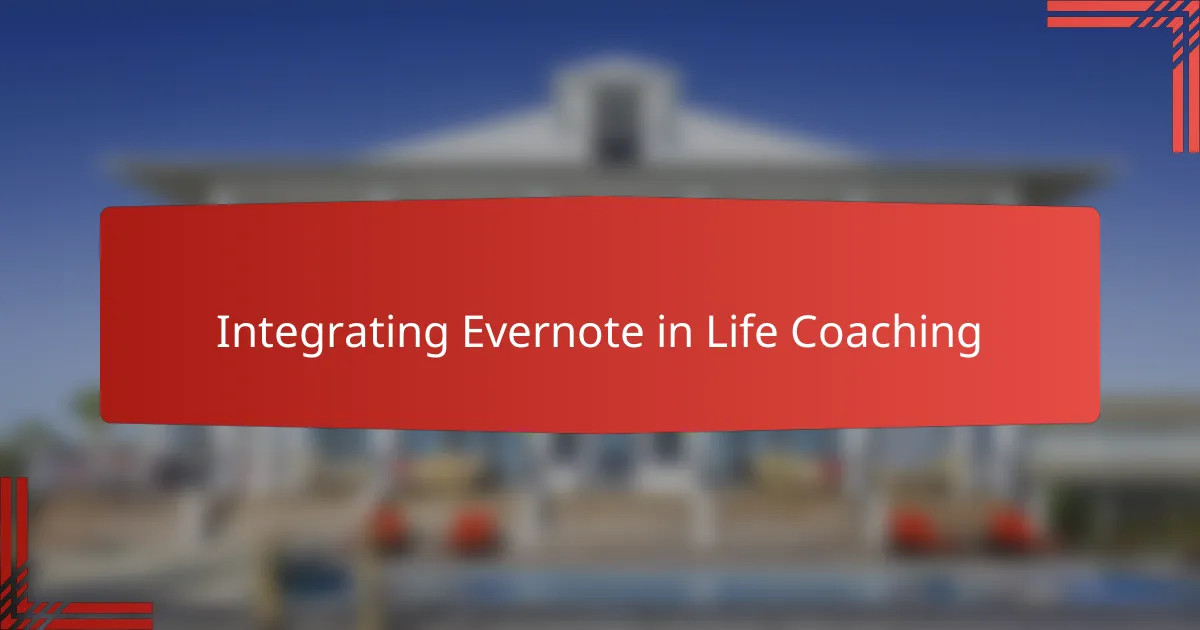
Integrating Evernote in Life Coaching
Integrating Evernote into life coaching sessions has transformed the way I support clients in organizing their goals and actions. I recall one coaching experience where having a shared Evernote notebook allowed us to track progress in real time, making the entire process transparent and motivating. Have you ever tried collaborating on goal-setting without a central place to capture ideas? That mess of emails and notes can easily derail momentum.
What I find powerful about using Evernote in my coaching practice is how it encourages clients to externalize their thoughts while still feeling in control. The ability to add voice memos, images, and checklists caters to different learning and planning styles. From my perspective, this multimodal approach helps clients feel seen and understood, which deepens engagement and accountability.
Sometimes, the simplest feature makes the biggest difference. For example, when I prompt a client to tag notes by themes or priorities, it sparks an “aha” moment about organizing their life beyond just scheduling. It’s those small shifts in thinking—enabled by Evernote—that often lead to real, lasting change. Isn’t that what effective coaching is all about?
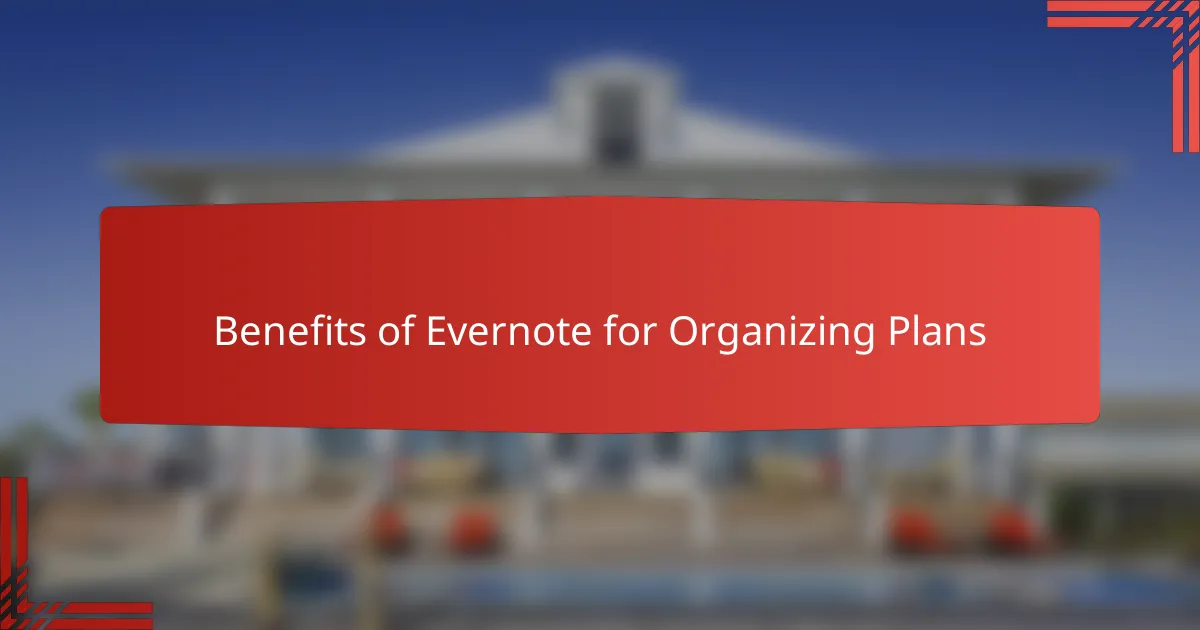
Benefits of Evernote for Organizing Plans
One of the biggest benefits I’ve found with Evernote is its powerful search function. I remember struggling in the past, flipping through countless papers or scrolling endlessly to find a single note. With Evernote, a quick keyword search brings up exactly what I need in seconds—saving me both time and frustration. Have you ever lost track of an important idea just because it was buried somewhere you couldn’t find? This feature feels like a personal lifesaver.
Another advantage that really stands out to me is how Evernote keeps everything synchronized across devices. Whether I’m on my phone, tablet, or laptop, my plans and notes are always up to date. This seamless connection has helped me stay organized even when I’m on the move, which is essential in community life coaching where flexibility often rules my day. Isn’t it reassuring to know your plans are with you, no matter where you go?
Evernote also allows me to combine different formats—text, images, voice clips—within a single note, which matches how my mind works best. When I’m brainstorming a community event, for instance, I can capture a catchy idea with a photo, follow it up with a quick voice recording, and then flesh it out in writing. This blend makes the planning process feel dynamic and alive, rather than static and dull. Don’t you think organizing plans should feel this engaging and personal?
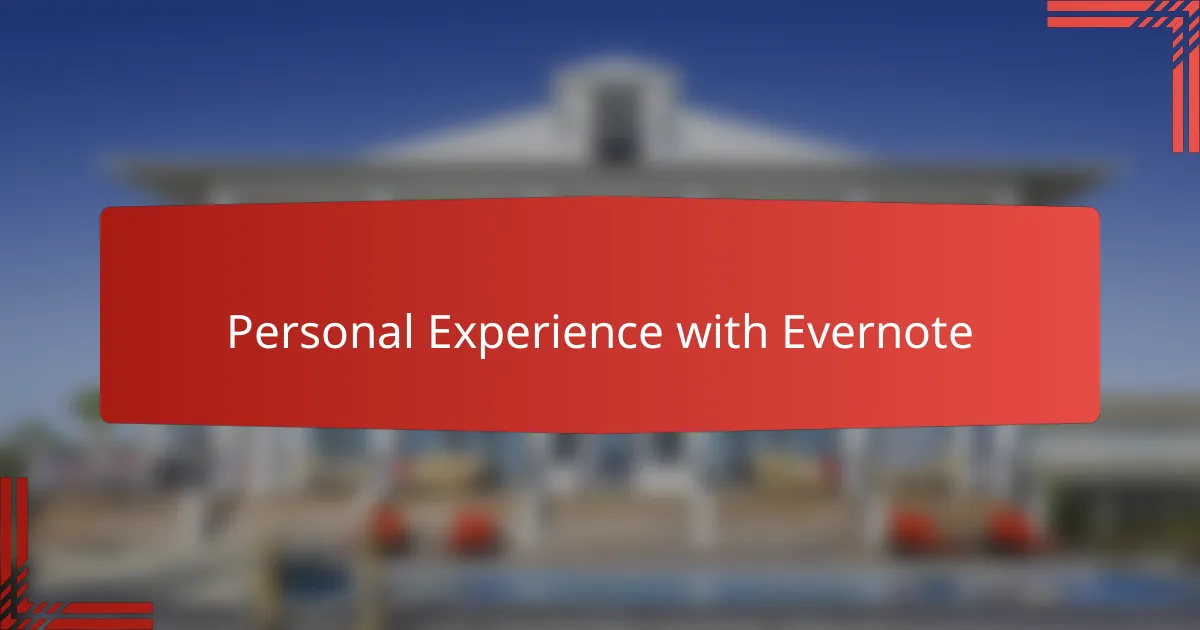
Personal Experience with Evernote
When I first started using Evernote, I was honestly curious but a bit skeptical about how much it could really help me organize my plans. Yet, after a few weeks, I found myself relying on it daily—juggling everything from simple reminders to complex project outlines. Have you ever had that moment when a tool just clicks with the way you think? That’s exactly how Evernote felt for me.
One particular time stands out: I was planning a community event and had countless ideas scattered across emails and sticky notes. Moving everything into Evernote not only eased my stress but actually sparked new connections between ideas I hadn’t noticed before. I remember feeling this satisfying sense of clarity, like the fog had lifted. Isn’t it amazing how a good organizational system can free your mind to be more creative?
Sometimes, the real value lies in the small things. For example, the ability to add checklists and reminders that sync across all my devices helped me stay on track even on hectic days. I can’t count the number of times I caught myself smiling when a timely notification nudged me back to an important task. Doesn’t having that kind of reliable nudge make all the difference when life gets busy?
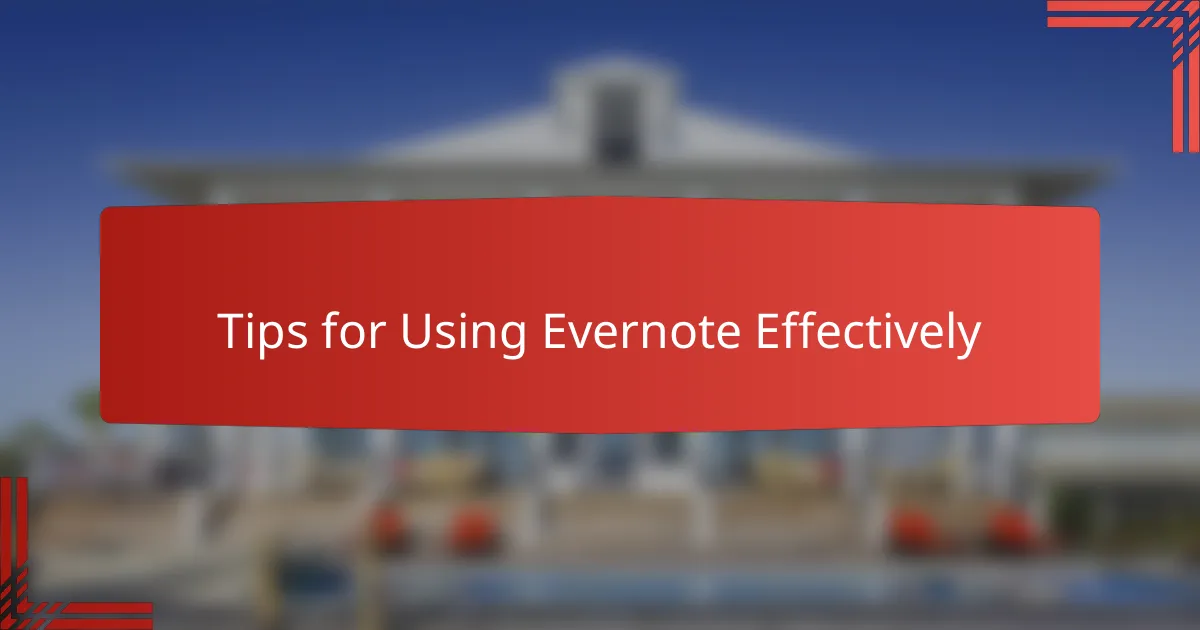
Tips for Using Evernote Effectively
One tip I’ve found essential for using Evernote effectively is to develop a consistent system for tagging your notes. Early on, I used tags loosely, and that vague approach made finding things harder than it should be. Once I started applying specific tags—like “community event,” “urgent,” or “follow-up”—searching became a breeze. How often do we underestimate the power of simple organization habits until we experience that sweet moment of instant retrieval?
Another practical tip is to make use of Evernote’s template feature. I’ve found that creating templates for recurring plans, such as meeting agendas or workshop outlines, saves me a ton of time and mental energy. Instead of starting from scratch each time, I just pull up a template and customize it. Have you ever felt drained by repetitive setup tasks before the real work begins? Templates can really lift that burden off your shoulders.
Finally, don’t overlook the small but mighty reminders within Evernote. Setting due dates and notifications on key notes has, on more than one occasion, saved me from missing deadlines or letting important steps slip through the cracks. It’s like having a gentle but reliable coach tapping your shoulder when focus drifts. Who doesn’t appreciate that kind of support when juggling multiple plans and priorities?
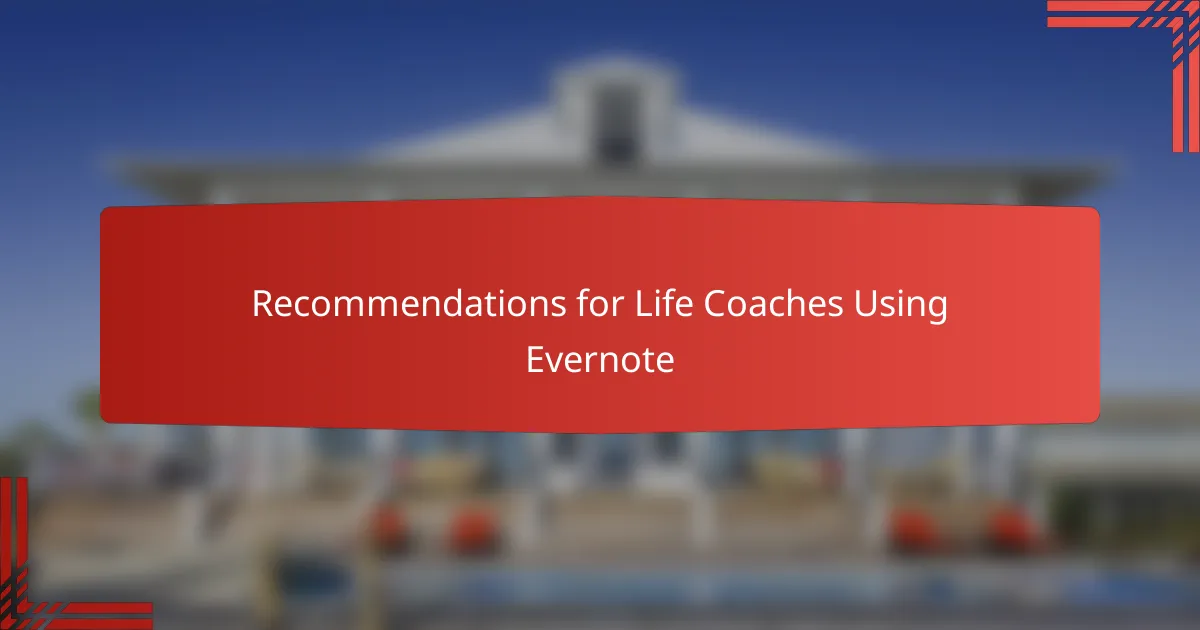
Recommendations for Life Coaches Using Evernote
For life coaches, I recommend using Evernote’s shared notebooks to foster transparent communication with clients. In my experience, having a live, collaborative space where both coach and client can add notes and track progress builds trust and keeps everyone motivated. Have you tried sharing a notebook and noticed how it shifts the coaching dynamic into a more proactive partnership?
Another recommendation is to leverage Evernote’s tagging system to organize clients’ goals by priority or theme. I remember when I first applied this, it sparked a real “aha” moment—not just for me but for my clients too—because it made complex plans feel manageable and clear. Isn’t it easier to guide someone when their goals are neatly categorized and easy to access?
Finally, I suggest customizing templates within Evernote for common coaching sessions or follow-up check-ins. This little habit freed up so much mental space for me because I wasn’t reinventing the wheel every time. Have you ever felt the frustration of starting from scratch over and over? Templates help keep the coaching process smooth and consistent, which ultimately benefits both you and your clients.